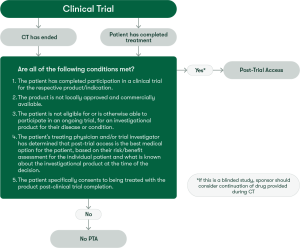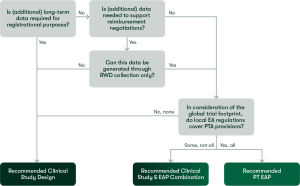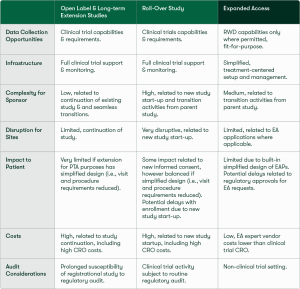This article was updated in April 2025 to incorporate new ethical guidelines, regulatory requirements, and industry best practices.
Clinical trials are essential for developing innovative treatments, generating the safety and efficacy data required to support regulatory approvals, reimbursements, and ultimately, broad patient access. These trials rely on the commitment of patients willing to participate in testing investigational treatments and advance medical research.
However, there is often a time gap between trial completion and treatment approval. This gap, which can vary significantly across countries, can mean that the very patients who contributed to its development lack access to the therapies from which they could benefit.
This issue represents an ethical dilemma interconnected with the four main principles of biomedical ethics1 :
Consequently, planning for “Post-Trial Access” (PTA) – the provision of an investigational treatment to patients who have completed a clinical trial – is a critical part of clinical development. In practice, PTA planning must address a broad range of access-related challenges including treatment specific supportive medical care, infrastructure required for treatment administration, and the associated costs.
While increasingly refined ethical guidelines have brought attention to the importance of PTA, the continued variability in regulatory requirements and country-specific guidance makes implementation complex. Sponsors must address development-specific and logistical aspects such as program sustainability, operational feasibility, and long-term viability—all while adhering to regulatory and ethical guidelines.
In this article, we explore the evolving landscape of PTA—from ethical foundations and global regulatory frameworks to implementation best practices. You will gain clarity on current available mechanisms and discover how Expanded Access (EA) can serve as a practical solution that balances patient centricity, regulatory compliance, and operational feasibility.
Given that the International Council for Harmonization (ICH) guidelines for Good Clinical Practice (GCP) 2 do not explicitly address PTA, sponsors and researchers have traditionally relied on other established international ethical frameworks such as the Declaration of Helsinki to navigate decisions regarding PTA.
Established in 1964 by the World Medical Association in response to unethical medical research performed during WWII, the Declaration of Helsinki outlines basic ethical principles for medical research involving human participants. It has been subject to several revisions to accommodate advancements in medical research and evolving ethical considerations.
A 2013 revision introduced post-trial provisions as a distinct ethical principle. 3 This was further expanded in the 2024 update, which states:
This update emphasizes the importance of proactive planning, transparency, and shared responsibility among sponsors, healthcare systems, and governments in addressing patient access along the development path. It also underscores the important role that ethics committees play in balancing ethical considerations.
In collaboration with the World Health Organization (WHO), the Council for International Organizations of Medical Sciences (CIOMS) also addresses PTA in the International Ethical Guidelines for Biomedical Research Involving Human Subjects. 5 The guidelines encourage:
These guidelines also address important nuances related to PTA, including managing transitions to PTA in the context of blinded controlled trials, as well as appropriate termination of PTA such as in the case of a pre-determined duration or the local availability of approved alternatives.
Notably, the Post-Trial Responsibilities: Continued Access Taskforce of the Multi-Regional Clinical Trials (MRCT) Center of Brigham and Women’s Hospital and Harvard developed and published a practical framework to support the interpretation and fulfillment of existing ethical guidance related to PTA. This framework offers concrete tools to guide decision-making, planning, and cross-stakeholder alignment. 6
While international ethical guidelines have advanced the harmonization of PTA principles, global regulatory requirements are variable and regulatory guidance remains highly fragmented. Where some jurisdictions have distinct mandates for PTA, others leave decisions to sponsors and/or ethics committees. This regulatory ambiguity makes implementation challenging. For example, compliant pathways for PTA delivery differ widely: some countries have established distinct PTA importation pathways, others allow researchers to leverage Expanded Access (EA) pathways, while others restrict access solely to clinical trials.
Understanding and navigating global PTA regulatory variability is necessary to develop compliant PTA programs, especially in the ever-expanding global clinical trial footprint. Some key markets are addressed here:
While the United States (US) Food and Drug Administration (FDA) regulations on GCP and clinical trials emphasize the protection of human subjects, they do not explicitly mandate PTA. However, the FDA does recognize the Declaration of Helsinki as an internationally accepted set of ethical principles that can inform regulatory expectations.
Furthermore, although the US FDA Expanded Access (EA) regulatory guidelines do not explicitly reference PTA, a 2019 statement from former FDA Commissioner, Scott Gottlieb, acknowledged EA as an appropriate mechanism for PTA when the “primary purpose is to provide the drug to patients who continue to need it” as “an acknowledgement of the contribution these patients have made to the overall drug development program. 7”
Similar to the US, the European Union’s Clinical Trials Regulation (EU No 536/2014) 8 does not explicitly address legal requirements for PTA, but the regulations are underpinned by the ethical principles of the Declaration of Helsinki which influence the interpretation and application of regulations and GCP.
Implementation of PTA varies across member states, and local ethics committees often play a key role in shaping expectations during protocol review. Specifically, compassionate use and named patient basis treatment pathways are coordinated and implemented by member states which set their own rules and procedures, and so the applicability of these EA pathways across the region vary greatly.
There are a number of countries that explicitly address PTA obligations.
Law No 14,874/2024 which regulates clinical trials with human subjects in Brazil requires that sponsor’s guarantee free-PTA whenever it is considered by the researcher as the best therapy for the patient and presents a more favorable risk/benefit ratio compared to other available treatments. The law also requires that sponsors submit PTA plans as part of the ethics approval process and define circumstances under which PTA may be appropriately terminated.9 Brazil has even defined a specific pathway for PTA, called Post-Study Drug Supply Program.
India, South Africa, Argentina, Chile, Peru, and Finland have regulatory provisions that require sponsors to provide PTA under specific circumstances. Other countries such as Canada and Japan offer non-binding guidance, leaving significant discretion to sponsors, investigators, and ethics committees regarding the provision of PTA. Notably, both countries explicitly exclude PTA from the scope of their EA regulatory frameworks, limiting PTA programs to clinical trial.
As PTA gains heightened global attention as a critical component of the ethical treatment of patients participating in clinical research—with significant practical implications for sponsors, researchers and healthcare systems—one can expect increased focus from regulatory authorities, potentially with a more targeted approach and application. The evolving patchwork of regulations highlights the importance for sponsors to evaluate potential PTA obligations as part of clinical trial feasibility assessment to ensure country selection does not come with unanticipated commitments that are difficult to address on an ad hoc basis.
Given that ethical guidance emphasizes early transparency with patients and researchers, and regulatory requirements vary significantly across markets, sponsors are best positioned when taking a holistic approach that considers how PTA is planned, communicated, and delivered. While each development program may present unique challenges and considerations, early organizational alignment on PTA decision-making and management can facilitate an ethical, effective, and more sustainable approach.
A company-wide PTA policy provides a critical foundation for consistent, program-specific decision-making and enhances transparency with the broader healthcare community about the organization’s general approach to PTA. It enables cross-functional alignment on key factors—such as clinical benefit, unmet need, or development stage—that inform whether and how PTA may be offered across different programs.
Having a PTA policy that is publicly facing, for example via the corporate website, also reinforces a commitment to patient centricity, transparency, and accountability. Although the decision to provide PTA may vary by program, a general PTA policy helps manage expectations and build trust with external stakeholders, including patient advocacy groups (PAGs), prospective clinical trial participants, and researchers.
PTA planning tailored for a specific development program should be integrated with other clinical trial planning activities and involve all key stakeholders. To determine the necessity for PTA, sponsors should consider appropriate delivery mechanism(s), overall scope, and other factors including:
The clinical trial design itself can also have an impact on PTA approach and transitions. For example, is it a randomized placebo-controlled trial? Or is there a mandatory safety follow-up visit needed post-end-of-treatment?
Early PTA assessments also promote transparency in study-related documents & communications. While the final PTA decision may depend on variables like interim analysis results, outlining the commitment and conditions upfront is crucial. Key recommendations for sponsors to maximize transparency include:
Sponsors are advised to include dedicated sections in their common protocol and informed consent templates regarding access to treatment following study completion, with recommended template language to ensure consistency in communication.
Planning for PTA also requires anticipating organizational and logistical implications of continuing treatment after a trial. Considerations include:

Deciding about whether or not to provide PTA is only one half of the equation; the other half is determining the most appropriate mechanism to deliver PTA. There are two general categories for PTA mechanisms: 1) clinical trials which includes open-label extension studies; roll-over studies; treatment arms, and 2) Expanded Access.
The right approach depends primarily on the intent of the PTA program:
Another determining factor is the regulatory feasibility to pursue different PTA mechanisms. As previously mentioned, sponsors must carefully navigate regulatory complexity and nuance to ensure a compliant approach. Some countries may restrict access to clinical trials, some may permit EA pathways to be leveraged, others may not explicitly address the topic.

Open-Label Extension (OLE) and Long-Term Extension (LTE) studies are typically used when the goal is to transition patients to active investigational treatment while collecting long-term safety, tolerability, and efficacy data which may be needed for registrational purposes. These studies:
Rollover studies are appropriate when continued access is needed within a trial framework and involves patients transitioning or “rolling over” from a completed clinical trial into a new study.
These studies:
Country specific EA regulatory pathways provide access to investigational treatments to patients without access to satisfactory treatment alternatives, outside of the clinical trial setting. EA and Expanded Access Programs (EAPs) are a valuable tool to leverage for PTA purposes given they:
Choosing the right mechanism(s) requires aligning the access pathway with its intended purpose, whether it’s data generation, treatment continuity, or both. When done well, this not only supports a patient-centric approach, but also ensures operational and regulatory alignment across global development programs.
To understand the nuances between various pathways that are currently used, we have summarized an overview in the table below. Among the available mechanisms, Expanded Access has emerged as a particularly flexible and strategic option—especially when traditional trial mechanisms are not necessary.

EAPs are increasingly being recognized as a strategic mechanism for PTA, especially when additional data from clinical trials is not needed and/or commercialization in a given country is not planned. EA represents a more sustainable solution for PTA, which ensures that BioPharma companies can direct resources to support the development of other new treatments or support activities that will result in more broad global access.
A well-designed EAP can facilitate the provision of PTA for patients completing clinical trials and allows a company to pivot to support access for treatment-naïve patients who may not be eligible for or have no access to clinical trials. Along the development path, sponsors may decide to expand the scope of an EAP as more data becomes available, as market access strategies and commercial launch plans develop, or as insights into the global unmet need mature.
While EAPs are designed first and foremost to provide treatment, they also present opportunities to generate RWD in non-interventional study settings. When permitted by local regulations, RWD collected through EAPs can offer valuable insights into real-world safety, treatment patterns, and patient outcomes. This data may support regulatory filings, inform Health Technology Assessments (HTAs), and strengthen market access strategies. 10
EA is often the most practical mechanism for PTA when:
While regulatory requirements vary, most EA regulations are structured around the following patient criteria:
Transitioning from a clinical trial to an EA setting requires careful planning including:
Internal alignment is critical across clinical, regulatory, medical, supply chain, pharmacovigilance and patient access functions.
Lastly, clear communication is essential. Patients and physicians must understand what changes they should expect, including the expectations and conditions for PTA, how treatment will continue, and who is responsible for ongoing support. Even though EAPs do not fall under clinical trial regulations, safety reporting, tracking, and oversight remain mandatory.
At myTomorrows, we help BioPharma companies realize compliant, scalable, and sustainable PTA programs.
We support sponsors by providing:
Our services are designed to reduce complexity, accelerate setup, and ensure compliance across geographies.
As the clinical research landscape evolves, so too must the approach to PTA. What was once considered a discretionary gesture is increasingly recognized as an ethical, strategic, and—in some jurisdictions—a regulatory obligation. While frameworks like the Declaration of Helsinki and CIOMS set clear ethical expectations, it is up to sponsors to translate these principles into practice.
From early planning and transparent communication, to choosing the right access mechanism—whether through trial extensions or EA—ensuring continuity of care requires foresight, coordination, and a patient-centered mindset. EA has emerged as a powerful tool, not only to uphold ethical responsibilities, but also to generate meaningful real-world insights, support global development strategies, and build trust with patients and investigators. In this way, a thoughtfully executed PTA can also deepen site relationships and support future trial recruitment.
Looking to operationalize PTA through EA? Contact myTomorrows to explore how we can support you.
[1] Beauchamp, T. L., & Childress, J. F. (2013). Principles of biomedical ethics (7th ed.). Oxford University Press.
[2] International Council for Harmonisation. (n.d.). E6(R3) Addendum. Retrieved from
https://database.ich.org/sites/default/files/ICH_E6%28R3%29_Step4_FinalGuideline_2025_0106.pdf
[3] World Medical Association. World Medical Association Declaration of Helsinki: ethical principles for medical research involving human subjects. JAMA. 2013;310(20):2191-2194. doi:10.1001/jama.2013.281053
[4] World Medical Association. World Medical Association Declaration of Helsinki: ethical principles for medical research involving human participants. JAMA. 2024. doi:10.1001/jama.2024.21972
[5] Council for International Organizations of Medical Sciences. (2016). International ethical guidelines for health-related research involving humans. CIOMS.
[6] MRCT Center. Framework: Post-trial, Continued Access Responsibilities to Investigational Significant-Risk Devices – Scenarios that require further consideration. Multi-Regional Clinical Trials Center of Brigham and Women’s Hospital and Harvard; April 2025.
[7] U.S. Food and Drug Administration. (2019, January 31). Statement from FDA Commissioner Scott Gottlieb, M.D., and Director of FDA’s Center for Drug Evaluation and Research Janet Woodcock, M.D., on FDA’s ongoing efforts to advance the development of treatments for opioid use disorder. [Press release]. Retrieved from https://www.fda.gov/news-events/press-announcements/statement-fda-commissioner-scott-gottlieb-md-director-fdas-center-drug-evaluation-and-research-janet
[8] European Parliament and Council of the European Union. (2014). Regulation (EU) No 536/2014 of the European Parliament and of the Council of 16 April 2014 on clinical trials on
medicinal products for human use, and repealing Directive 2001/20/EC. Official Journal of the European Union, L 158, 1-76.
[9] Brazil. (2024). Lei nº 14.874, de 28 de maio de 2024. Retrieved from
https://www.planalto.gov.br/ccivil_03/_ato2023-2026/2024/lei/L14874.htm
[10] Polak, T. B., Cucchi, D. G., van Rosmalen, J., & Uyl-de Groot, C. A. (2022). Real-world data from expanded access programmes in health technology assessments: a review of NICE technology appraisals. BMJ open, 12(1), e052186.
Dennis Akkaya
Chief Commercial Officer at myTomorrows
Previously Kempen & Co Life Sciences. Dennis is responsible for developing strategic partnerships across all stakeholders. With 9+ years of expertise in EA and Clinical Trial Recruitment, as well as a vast industry and expert network, Dennis plays a key role in the pre-approval access space as an established thought leader, hosting conferences and webinars.
Stephanie Ferket
Director, Expanded Access Strategy and Customer Success at myTomorrows
With 8 years of experience in Expanded Access Programs, Stephanie most recently led the transformation of the access to medicines framework for Alexion, AstraZeneca Rare Disease, and managed Expanded Access strategy development & operational execution across all therapeutic areas.
Dennis Akkaya 2 Sep 2020